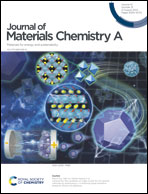Edge- and bridge-engineering-mediated exciton dissociation and charge separation in carbon nitride to boost photocatalytic H2 evolution integrated with selective amine oxidation†
Abstract
Carbon nitride holds a great interest in the photocatalytic hydrogen evolution integrated with selective amine oxidation (HAR) process. However, C3N4 often suffers from strong intrinsic coulombic interactions, random charge carrier transfer, and poor active sites, which lead to its unsatisfactory photocatalytic efficiency. Herein, embedded edge and bridge units in the carbon nitride framework (EBCN) were synthesized by a facile polymerization method. DFT simulation and experimental results suggest that the electron-withdrawing edges perturbed the electronic structure of C3N4 to promote the exciton dissociation as well as acted as active sites, whereas the bridge groups served as electronic channels for directional electron delivery, which enlarged the built-in electric fields and promoted interfacial carrier transfer and exciton dissociation. Consequently, EBCN exhibited an outstanding hydrogen generation rate (2296.3 μmol g−1 h−1) and high selectivity of imines (>99%) as well as good stability without using any solvent under light irradiation. This work not only paves a facile route to promote exciton dissociation and charge separation but also provides a novel catalyst for the photocatalytic H2 evolution integrated with selective amine oxidation.



 Please wait while we load your content...
Please wait while we load your content...